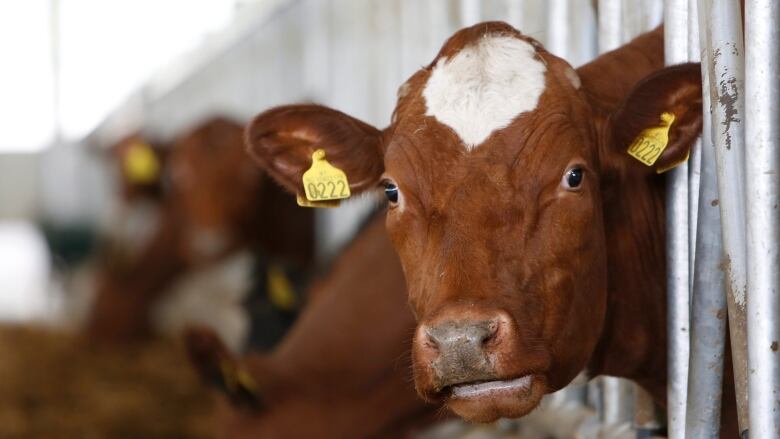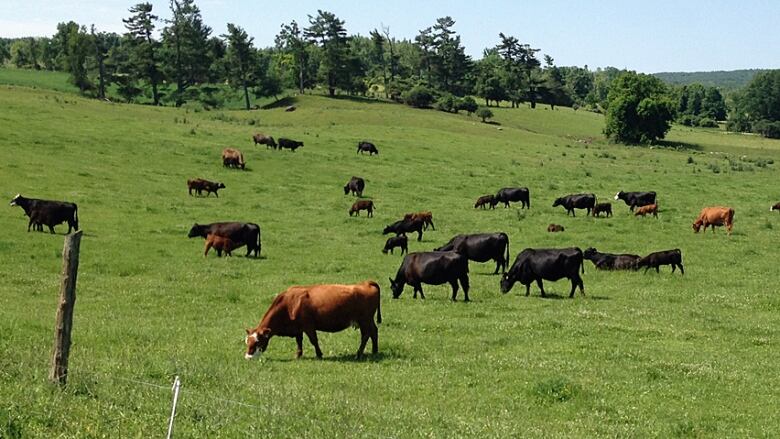Global demand for beef sends steak and hamburger prices sizzling
Worldwide demand encouraging Canadian ranchers, but Prairie drought holding things back

Getaway Farm co-owner Chris de Waal has watched Canadian beef prices keep going up and up and up, and yet customers at the farm's two butcher shops in Halifax still buy steaks and roasts.
Maybe those customers are asking for less beef than they used to. And maybe they're trying more obscure, less expensive cuts like flat iron or skirt steaks.

But they still want the beef that comes from the grass-fed herd Getaway raises in the Annapolis Valley.
"Say a consumer is going to come in and spend $20 with us half of that money will still go to beef. It isjust that the volumeof beef that we've put through has dropped because we've had to put our prices up," says de Waal.
What's happening is a complex economic lesson in beef supply and consumer demand, fuelled in large part by market forces and protein-loving appetites beyond Canadian borders.
- Alberta beef prices hit record high amid dry conditions
- How to make the most of your meat budget
- High beef prices force social agencies to find protein alternatives
Earlier this week, Statistics Canada reported that Alberta beef prices hit a record high in May: $192.80 for 100 pounds at slaughter. That comes as beef prices have risen by more than 40 per cent across Canada on average over the past three years.
Figures from Statistics Canada show, for example, that the price for one kilogram of prime rib roast rose about 30 per cent, from $22.44 in May 2011 to $29.21 in May 2015. Even the price for one of the most humble cuts ground beef went up, rising about 53 per cent, from $8.24/kg to $12.64/kg, in the same time period.
Will it ever come down?
Inside and outside the Canadian beef industry, which has seen its overall herd shrink in recent years, there are few if any voices suggesting a decrease in beef prices is likely any time soon.

"Because of how the [worldwide] demand for protein is structured, it's highly unlikely that prices will actually ever drop," says Sylvain Charlebois, a professor of food distribution and policy at the University of Guelph in southern Ontario.
"To keep proteins within our borders will become increasingly difficult and so consumers will have to pay more," he says, noting there are trade agreements that make it enticing to send Canadian beef to places such as Korea, Europe and other markets that are willing to pay a premium for beef and pork.
"In Canada, prices are low," Charlebois says. "There are always going to be some supplies for the Canadian market,but it will cost more to produce beef and pork, and to also have these products into our grocery stores, it's going to be very tough to see prices go down."
What about pork or chicken?
But if beef prices are unlikely to go down, how high could they conceivably go?
Charlebois figures they have reached a "very critical point" in their ascent.
"There are lots of substitutes out there. If consumers believe that beef prices are much too expensive, they'll just walk away and buy something else."
In fact, while pork and chicken have also risen in price, the jump hasn't been nearly as noticable.
We were starting to see young producers become interested again.- Rich Smith
So far, beef lovers haven't walked away, even if they may be buying less, or choosing less expensive cuts.
"We've been gratified by the degree to which the demand for beef has stayed relatively strong," says Rich Smith, executive director of Alberta Beef Producers.
Still, he knows "there'd be a point at which people would turn away from it."
And while hedoesn't think that point has been reached,"we're getting close to it."
In the meantime, economic conditions would seem prime for farmers to consider expanding their herds, something that could boostbeef supply.
The current drought is holding some back, but"we were starting to see young producers become interested again and coming into the industry," says Smith.
Lack of rain
Still,any decision to expand herds won't mean immediate relief in the supply chain.
For any one farmer deciding to boost a herd, it would take two to three years before there would be cows bred and calves produced to reachmarket weight. In the short term, supply could also be even more limited as producers hang onto animals, keeping them for breeding stock.
All in, says de Waal, "the beef game is very difficult."

In his case, while retail prices have been increasing, Getaway Farm's margins haven't.
"We haven't put our prices up at pace with the increase in price at all," de Waal says, noting that Maritime shoppers "are very price conscious."
"We can't get away with the prices that folks in Toronto and Vancouver are getting away with for grass-fed beef. In order to even just keep our product competitive, we have to seriously fight to keep our prices low.
"Our whole mandate is to raise sustainable, ethical, healthy grass-fed beef and then take them directly to the consumer and unfortunately for us, we're in the crux of the highest market forces that have ever been."












_(720p).jpg)


 OFFICIAL HD MUSIC VIDEO.jpg)
.jpg)



























































































